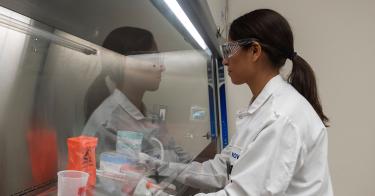As the world battles the COVID-19 pandemic, the White House has warned time and time again that a vaccine for the SARS-CoV-2 virus won’t be available for another 12 to 18 months.
In a crisis, that sounds like forever.
>>> When can America reopen? The National Coronavirus Recovery Commission, a project of The Heritage Foundation, is gathering America’s top thinkers together to figure that out. Learn more here.
In the 2011 movie “Contagion,” the valiant researchers at the Centers for Disease Control and Prevention manage to discover the cause of the disease, develop the vaccine, and, by Day 131, start inoculating Americans.
So, why can’t we do the same?
It turns out that the real world is more challenging. Vaccine development is a complex, multistep process that includes rigorous clinical testing and regulatory hurdles.
Throughout the vaccine development process, scientists, policymakers, and government regulators must constantly walk the tightrope between speed, efficacy, and product safety to produce a vaccine that creates a neutralizing immune response to the virus.
With that in mind, let’s take a look at the process.
Step 1: Research
Identify the pathogen: Before a vaccine candidate can be developed, the biological pathogen must be identified, isolated, and analyzed in a laboratory. This process includes genetic sequencing to get an understanding of the virus’ structure.
Develop a candidate: Traditionally, vaccines are developed by “growing” pathogens that are either inactive or reduced in potency. Once injected into a host, these trigger an immune response to protect against the real virus.
Preclinical testing: Before a vaccine can be tested in humans, it’s investigated carefully in a lab. This step usually involves animal trials, but regulators have allowed researchers to skip this step to fast-track development of a SARS-CoV-2 vaccine.
Step 2: Human Clinical Trials
Once a vaccine candidate is identified and clears preclinical testing, scientists prepare it for human studies. What works in the lab doesn’t always work in human hosts.
Clinical trials are usually conducted in three phases.
Phase 1: Potential vaccines are given in small doses to healthy human volunteers. These studies are designed to make sure the vaccine is safe while determining proper dosage. Phase 1 studies rarely have more than 100 people, and many begin with fewer than two dozen volunteers.
While Phase 1 trials usually take at least a year, experts predict they will take approximately three months for COVID-19 vaccine candidates.
Phase 2: If a vaccine candidate clears phase 1 successfully, it can be tested on larger numbers of people. During phase 2 trials, an established dosage is given to subjects to determine “how reproducible and consistent the immune response is” and to identify possible side effects.
Usually, scientists conduct several phase 2 studies involving a few hundred patients per trial. Phase 2 trials for COVID-19 vaccines are expected to take eight months. For other vaccines, phase 2 studies usually take two to three years.
Phase 3: Next, a vaccine is tested on a much larger scale. Phase 3 trials can involve tens of thousands of people and screen for rare side effects. They also determine whether a vaccine actually provides protection against a disease.
To speed up the process, COVID-19 vaccine developers may combine phase 2 and phase 3 trials. After phase 3, the vaccine is submitted for approval and then used clinically.
Phase 4: After a vaccine is on the market and in clinics, prescribers monitor its use for potential adverse reactions that are reported to the manufacturer to ensure its continued safety.
Step 3: Regulatory Hurdles
Before a vaccine can be distributed to the general population, it undergoes careful scrutiny from government regulators at the Food and Drug Administration.
Given the seriousness of the COVID-19 pandemic, the FDA will likely continue doing everything it can to fast-track the regulatory process for promising vaccines.
Step 4: Manufacturing and Distribution
Once a vaccine is approved, it must be produced in huge quantities to provide immunity to a large number of people. Because manufacturing a vaccine involves specialized equipment and skilled labor, it’s a very costly process.
And, once one or more COVID-19 vaccines are completed, manufacturing hundreds of millions—if not billions—of doses will take time.
During a congressional hearing in early March, Dr. Robert Kadlec, health and human services assistant secretary for preparedness and response, testified that the United States could “have a longer than a six-month wait to basically produce vaccines on scale.”
Then, once a vaccine is produced, it must be distributed across the country—and the world. Expect state governments and the Trump administration to create plans and policies to guide vaccine distribution and administration as we get closer to a rollout.
Ultimately, creating an entirely new vaccine is a challenging and lengthy process. Indeed, there’s no guarantee of success. “Of vaccine candidates that begin clinical trials, only about 16% are ultimately approved,” The Wall Street Journal reported.
Thankfully, many of the top minds in the scientific and pharmaceutical industries in this country and across the world are hard at work on this task.
With the Trump administration working to support America’s private sector, a vaccine could be available in record time.
This piece originally appeared in The Daily Signal



